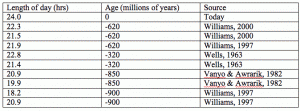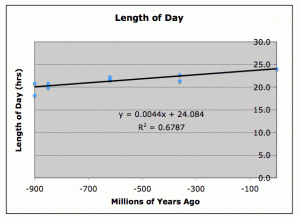As a paleontologist, I am daily looking backward into the depth of deep time. Regularly pondering phenomena, which occur across millions or billions of years. The daily, yearly or even decadal cycles that occupy most people’s minds seem like an infantilism small flash of time to me. To me 10,000 years seems like a rather short interval, when you daily consider that the Earth is 4,540,000,000 years old. Such an extended look at the nature of time, especially at these long scales, gives me ponderous thoughts to the far off future. You can imagine that I don’t have many friends. But one question keeps bothering me.
When will the Earth stop rotating? 
Few people stop to consider whether the Earth’s rotation will come to a stop one day. The spin of the Earth gives us the length of the day; the amount of time of daylight and the amount of time of night. But Earth’s days are slowing down, such that sometime far in the future the Earth could stop rotating.
Today the Earth takes 23 hours, 56 minutes and 4.1 seconds to complete a rotation. Because the Earth’s tilt, the amount of daylight varies depending on your location. This is why people in Alaska experience longer daylight during the summer months, and longer darkness during the winter months, but the length of the Earth’s spin remains at 23 hours, 56 minutes and 4.1 seconds. But does it?
Like a spinning top, the Earth is slowing down. Measuring the length of the day requires clicking a very accurate stopwatch each day, and recording the time it takes for Earth to make one rotation. For the most part it says pretty close to 23 hours, 56 minutes and 4.1 seconds. However, the length does fluctuate by about 4 to 5 milliseconds. In other words 0.004 to 0.005 seconds are added or subtracted from each day. These fluctuations appear to be on a decadal cycle, so the days in the 1860s were shorter by 0.006 seconds compared to days in the 1920s. These decadal fluctuations are believed to be the result of the transfer of angular momentum between the Earth’s fluid outer core and surrounding solid mantle, as well as tidal friction forces of the ocean as it slushes back and forth over the surface of the Earth while it spins. Weaker fluctuations occur over a yearly cycle, with days in June, July and August shorter by 0.001 seconds compared to days in December, January and February. These weaker fluctuations are cause by the atmosphere and ocean friction as the Earth spins, producing an oscillation called the “Chandler Wobble” after the American Scientist S. C. Chandler. In fact the Earth is not just a solid mass of rock, we have a liquid ocean and a gaseous atmosphere that impacts the length of each day. Its like we are a washing machine spinning around with wet clothes, and depending on where those clothes are in each spin cycle, there will be some variation in the speed of the spin itself.

Climate change also can have a rather important impact on the length of the day. If we were to compare the average day length during the last glacial period (25,000 years ago) to today, the day would be much shorter. This is because of the Earth’s polar moment of inertia has decreased. As the great polar ice sheets that covered much of the polar regions started to melt, the distribution of the Earth’s mass shifted, from near the center of the spinning planet at the polar (as ice sheets), toward the equator (as melted ocean water). This change in inertia is the same phenomenon you observe when an ice skater brings his or hers arms out during a spin. The speed of the spin slows down. So as the Earth’s great ice sheets melted over the last 25,000 years, the Earth, like the spinning ice skater, projected more of its mass outward from its center, slowing the spin.
While these fluctuations are interesting, they are small (several milliseconds), but we are interested in finding out when the Earth will stop spinning, and for that question we need a much longer record of day lengths, going back millions of years.
Fossil organisms keep records for the length of each year, month and day. Particularly fossil organisms that live in the inter-tidal zone where they are subjected to the twice daily tide caused by the rotation of the Earth and gravitational pull of the moon, amplified by the relative location of the sun. These changes in water depth result in a record in the growth rings of fossils corals that lived millions of years ago, as well as cyclic sediments such as tidal rhythmites and banded iron formations. Using this information, we can calculate the length of the day at various points in Earth’s history and then graph those points to see when in the future, the Earth will stop rotating.
I searched through the scientific literature to see how many points in the Earth’s past I could get for the length of the day at various early periods in Earth’s history. One problem I encountered is that paleontologists record the number of daily tidal growth rings, between more major yearly shifts. Thus we get a record of the number of days within each year. If we assume that the year (the length of time the Earth spins around the sun) remained the same, we can calculate the length of day.
Using these figures I then constructed a graph of each point, and ran a linear trend line through these data points to get a linear equation. Length of Day (hrs) = 0.0044x + 24.048 where X is equal to millions of years.
For each million year duration, the Earth’s day increases by 0.0044 hours.
This is only 15.84 seconds.
A million years from now people will get to enjoy an extra 15.84 seconds!
Wow that does not seem much.
If we are expecting to wait around until the Earth stops spinning, we are looking not at billions of years into the future, but much much longer, and as I come to realize – it will never stop spinning completely.
What is slowing the Earth down? Newton’s first law of motion states the following: An object in a state of uniform motion tends to remain in that state of motion unless an external force is applied to it.
What external force is being applied to our spinning Earth to slow it down? The answer is our nearest neighbor— the moon.
The moon is rotating around the Earth at a much slower pace, which like a brake being applied to the faster rotating Earth is slowing the Earth’s spin. Thus, the Earth will slow down until that moment in the future, when it will match the rotation of the moon around the Earth— 27.32 days or 559.68 hours. At this point the Earth will be locked with the same spin as the orbit of the moon around the Earth. However, the moon is moving slowly away from the Earth (1.5 inches), so it will take longer to orbit the Earth in the far future. With an estimated 47 days, but neither the moon nor the Earth will slow any further beyond this unless acted upon by some other external force, such as an giant asteroid. (Note there maybe some effect from other planets).
How long will it take for the Earth’s day reach 27.32 days?
And can you even imagine living on an Earth with a day the length of the month?
We can use our previous equation derived from the fossil and geological record.
559.68 hours = 0.0044x + 24.048 and solve for X.
We get 121,735 million years! That is 121 billion years!
That is a long long way off, given that the universe is only 13,800 million years old, and the Earth is only 4,540 million years old.
So sit back and relax we have many many more days to enjoy the length of our day!
References for plotted data:
Vanyo & Awramik, 1982. Length of day and obliquity of the ecliptic 850 Ma ago: preliminary results of a stromatolite growth model. Geophysical Research Letters 9(10):1125-1128.
Wells, 1963. Coral growth and geochronometry. Nature. 197:948-950.
Williams, 1997. Precambrian length of day and the validity of tidal rhythmite paleotidal values. Geophysical Research Letters 24(4):421-424.
Williams, 2000. Geological constraints on the Precambrian history of Earth’s rotation and the Moon’s orbit. Reviews of Geophysics 38(1):37-59.


